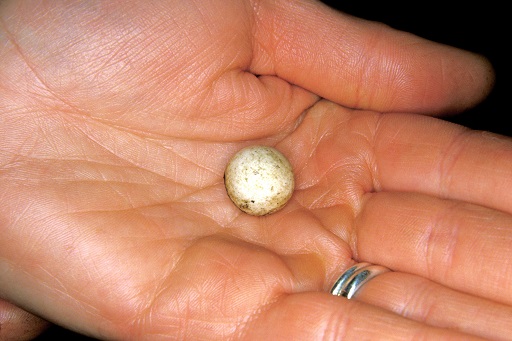3 The monotremes
The echidna and the duck-billed platypus, which are the only egg-laying mammals, are so distinct that they are assigned to a discrete subclass, the Prototheria, which includes the order Monotremata, separate from the more familiar and well-studied placental mammals. These two animals are termed ‘part-reptile, part-mammal’, a phrase that will be examined more critically in Section 3.1.
An extraordinary feature of monotremes that no other modern mammal has retained is that they lay eggs. This echidna egg (Figure 15) is tiny, only about the size of a marble. Early mammals must have laid eggs in the same way, a feature that they inherited from their reptile ancestors.
The reptile embryo feeds on a supply of highly nutritious yolk and, by the time the embryo hatches, it is sufficiently well-developed to go looking for food on its own.
By contrast, the platypus and echidna are very different from their reptilian ancestors. Their eggs are smaller, containing only a limited amount of yolk, and their young hatch in a far less developed state. They need a lot more nourishment if they're going to grow and survive.
Platypus young develop without having to leave their mother's burrow. Four months after hatching, a youngster emerges from the burrow for the first time and already it has grown to almost full adult size. That is thanks to an amazing form of nourishment that is a defining feature of all mammals: milk.
Here are two National Geographic video clips with more information about the platypus and echidna. Make sure you open these links in a new tab or window, so you can easily return to this page.
The platypus is semi-aquatic and can be found in streams and rivers in Eastern Australia, from tropical rain forests in Queensland to the much colder highlands of Tasmania, which feature in this video.
National Geographic: platypus video [Tip: hold Ctrl and click a link to open it in a new tab. (Hide tip)]
In this video of an echidna you can see the developing egg and the young echidna, called a puggle. The echidna is described in the video as ‘weird’, which is a description that is not really appropriate.
Activity 1
Write down the mammalian features evident in monotremes. Is their egg-laying habit similar in all ways to that displayed by reptiles?
Answer
Both echidnas and the platypus have fur – though in the former, some of the hairs are thickened in the form of spines.
Both animals produce milk – they have mammary glands, though well-defined nipples are not evident.
Immature young hatch from their soft-shelled eggs after about 10 days; reptiles typically hatch in a much more mature state. Thereafter, a young monotreme, though no longer carried, remains dependent on the mother’s milk – for more than six months in the case of echidnas.

